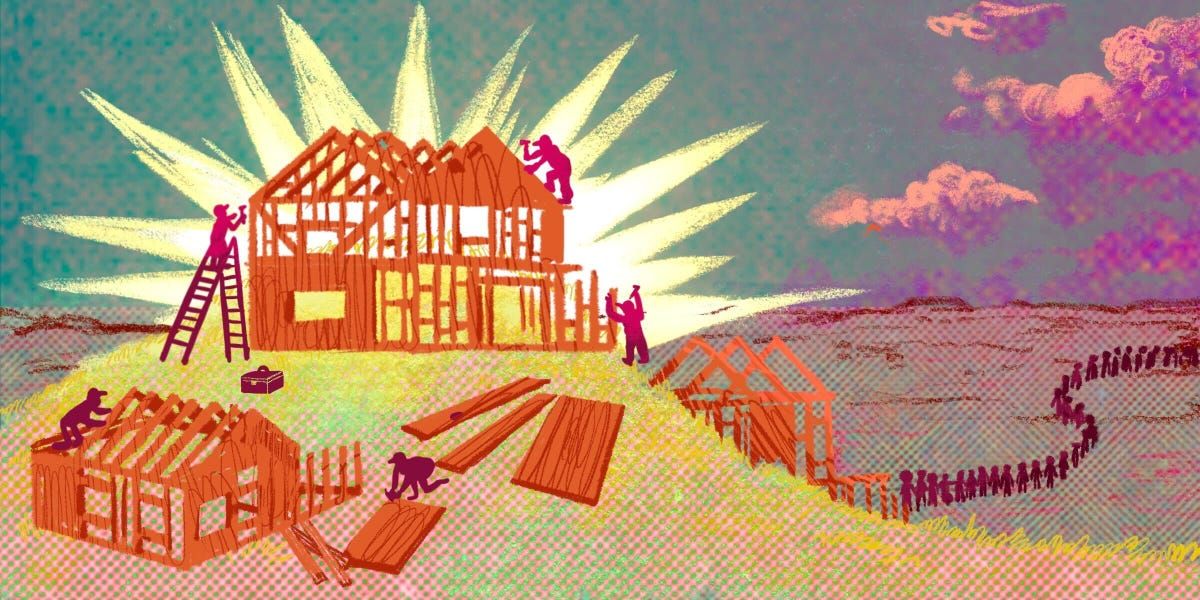The last, best hope for homebuyers
Prospective homebuyers — especially those trying to purchase a home for the first time — are trapped. People who already own a home aren't selling, mortgage rates are staying high, and competition for the few homes on the market remains stiff. Finding a warm place to lay your head in the middle of the housing market's Ice Age is proving difficult.
But there may be one last hope for salvation for these hard-pressed homebuyers: brand-spanking new houses. Recent data shows that the number of groundbreakings is shooting up, and there are other signs that more homes could be on the way: Builders are selling houses at a faster clip and feeling optimistic again, surveys show, which is typically an indication that they're going to start laying more foundations. And for renters, the historic number of newly built apartments on the horizon could start to bring down rents.
With many homeowners reluctant to move, buyers are going to become increasingly reliant on new construction. Not only are builders offering an alternative to the sluggish market for existing homes — it's clear that they're motivated to get newly built homes sold at a good price. Many builders are even dangling perks like cheaper loans or other discounts to ease the pain of higher mortgage rates. For some wannabe buyers, one economist told me, new construction represents "the only game in town."
The contours of this building boom are still fuzzy since experts are eagerly awaiting more data and builders continue to battle higher borrowing rates as well as a labor shortage. Homebuilding is typically a cyclical industry, following the ups and downs of the broader housing market. The pain of the Great Recession continues to loom large in the minds of builders, and new construction plummeted when the Federal Reserve began hiking interest rates last spring. But the tide appears to be turning again, as would-be sellers hunker down and buyers expand their searches beyond the existing pool of homes. If builders continue to gain confidence, this could mark an inflection point in the long-running battle against America's housing shortage.
Building boom
When the Census released its May update on new home construction late last month, the results shocked even the most dedicated housing prognosticators. Construction of new homes shot up dramatically to an annual pace of 1.63 million, a 22% increase from the month before and well above the -0.1% drop that economists forecasted. It was also the highest number of new foundations laid since April 2022, when rising mortgage rates were just starting to slow the market. The increase included month-over-month jumps for single-family homes, which were up 18.5% to an annual rate of 997,000, and multifamily homes, which were up 28% in the same period. Sales of newly built homes in May also reached an annual pace of 763,000, about 12% above the April rate and up 20% from a year ago.
"It was a huge surprise, from my perspective, on both housing starts and new home sales," Richard de Chazal, the macro analyst at William Blair, told me. "That activity, I thought, was going to continue to be weaker."
Typically, sales of both existing and newly constructed homes tend to move in the same direction, de Chazal told me. But the shock of higher mortgage rates and the vast disruptions during the pandemic have sent the two sales figures diverging, bucking that trend. In May, pending sales of existing homes were down 2.7% from the prior month and a whopping 22% below a year ago, according to the National Association of Realtors. And in June, roughly 26% fewer properties hit the market compared to last year, Realtor.com noted. New construction, on the other hand, accounted for nearly a third of all active listings in May, up from 16% in the same month in 2019, according to Redfin. And sales of new homes have been on the upswing for seven straight months after bottoming out last fall, according to a survey of production homebuilders by John Burns Research and Consulting, a housing research and advisory firm. In fact, those builders averaged 23% more sales last month than the June average from 2013 to 2019, more normal years for housing.
The divergence in home sales is a symptom of stubbornly high mortgage rates, which have more than doubled over the past 1 ½ years. With the average rate for a 30-year mortgage sitting near 7%, homeowners who bought their current houses before 2022 have little incentive to move, since that would force them to give up their historically low rates that guarantee them manageable payments for decades to come. Roughly 85% of mortgage holders at the end of May had an interest rate of 5% or lower, and about half had a rate of 3.5% or lower, according to Black Knight, a provider of mortgage technology and data.
"The existing-home market is frozen, and anyone who wants to buy a home is now forced to basically go to the new home market to get that supply," de Chazal told me. "So that's why I think you're seeing new-home sales moving up and existing-home sales that are still pretty weak."
Of course, people will always move for reasons that have nothing to do with mortgage rates. But the current dearth of sellers carries "obvious benefits" for homebuilders, Mike Simonsen, the president of Altos Research, told me.
"There's no indication anywhere in the data that there's a surge of existing homes coming to market," Simonsen said. "So that continues to bode well for new construction, because the people who own homes in the US have a remarkably good deal and they are unlikely to sell, maybe ever."
Homebuilders even have an advantage over existing homeowners who decide to sell for whatever reason. These firms can entice buyers with deals like rate buydowns, in which the builder pays to lower the mortgage rate either for the life of the loan or just for the first couple of years. On a $450,000 home, which is roughly the median sale price according to the Census, a buyer putting 20% down could save $85,000 over the lifetime of their 30-year loan if their interest rate were just one percentage point lower than the current rate.
Roughly 56% of builders offered incentives to buyers in June, according to the National Association of Homebuilders, up from 54% in May. Since the NAHB began surveying builders about incentives in 1995, the percentage offering these kinds of deal sweeteners had never fallen below 50% until July 2022, when it hit 43%. Usage of incentives has been on the upswing since, although it's still nowhere near the historical high of 86% in December 2008. Most regular home sellers don't feel motivated to front the money for a rate buydown since there are still plenty of buyers out there waiting to pounce on homes when they hit the market — and they're willing to pony up good money for them. But those who offer incentives get a leg up in the market.
"Builders have greater control over the interest rates on the mortgage that they can offer to homebuyers, so the payments are cheaper right now than you can get in the existing market. They look relatively more affordable," Simonsen told me. "As a result, we can see the builders are saying, 'Well, let's build more then. We have control and this advantage.'"
Though builders have an easier time making these types of deals work, regular home sellers probably won't feel the need to offer similar deals since attractive listings are still getting multiple offers and selling quickly amid the current inventory shortage, Sheryl Palmer, the CEO of the national homebuilder Taylor Morrison, told me.
"Most importantly, we're just undersupplied," Palmer said. "And that's been exacerbated by what people are calling the 'lock-in effect' of the resale market."
These advantages are starting to make homebuilders feel a little more cheery about their prospects. Sure, a quarter of builders told the NAHB last month that they had cut prices to boost sales — but that's down from 36% in November, the most recent peak. Supply-chain issues have eased significantly, and while the labor market is tight, the construction industry has still added 88,000 jobs this year. And looking at surveys of homebuilder sentiment, it's clear that optimism is on the rise. The NAHB's monthly index of homebuilder confidence rose to 55 out of 100 in June, continuing a general upward trajectory from a low of 31 in December. Anything higher than 49 is considered positive on the index, which ranges from 0 to 100.
"People are having to turn more toward new construction," Cristian deRitis, the deputy chief economist for Moody's Analytics, told me in mid-May. "Sometimes it's the only game in town."
Optimism with an asterisk
Experts I spoke with warned against getting too worked up over one month's numbers, particularly since the Census' estimates of housing starts are often revised after their release. On the multifamily side in particular, private developers and analysts like Jay Parsons, the head of economics for the real-estate software company RealPage, have expressed doubt about the size of the increase.
Matthew Walsh, an economist at Moody's Analytics, told me that while he was skeptical of the magnitude of the increase in single-family starts, he agreed that the direction was correct — welcome news for those hoping to see more housing construction.
"It's good news, but it should be taken with an asterisk," Walsh said. "Keep optimism measured."
Even if buyers get some relief from new housing construction, builders are still a long way off from bridging the housing shortfall. At the end of 2020, Freddie Mac pegged the housing shortage at 3.8 million units, while a recent report from Realtor.com estimated the gap at 2.3 million units. New housing starts would need to increase by about 50% from the 2022 pace to close that gap in just two to three years, the report said. But that's a tall order, especially since homebuilders dramatically pulled back production in the wake of the global financial crisis. From 2010 to 2019, builders started roughly 21,000 single-family homes per 1 million people each year, barely half as much as they were building in each of the three prior decades.
People are having to turn more toward new construction. Sometimes it's the only game in town.
"It is encouraging that homebuilders have ramped up production, but the supply from new construction takes time and remains insufficient," Lawrence Yun, the chief economist of the National Association of Realtors, said in a statement accompanying its report on pending home sales.
Builders are now at "a bit of an inflection point," Walsh told me. They're simultaneously buoyed by the lack of existing homes on the market, constrained by higher interest rates and labor shortages, and wary of overbuilding. Demand may be lower than during the wild days of 2021, but there are signs that it's stabilizing — another positive for the industry.
"I think the builders want to keep good momentum. Don't shut it off," Palmer told me. "Everyone's trying to find that middle ground and let production match the sales, because over the last 18 months, production's been way behind. And so, I think everyone's trying to find that real balanced sweet spot."
A scarcity of sellers has thrown the need for new housing into even sharper relief. If people keep choosing to stay in their homes longer, we'll grow ever more reliant on new construction to fill that gap.
James Rodriguez is a senior reporter on Insider's Discourse team.
Source: Business Insider


